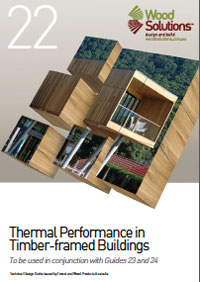The role of thermal mass in residential design is apparently simple, yet in practice it is frequently poorly understood and applied, especially in timber design and construction. Source: Timberbiz
For example, while it is often said that thermal mass is good, it is seldom recognised that too much, or poor application of thermal mass, can be counter-productive.
These are among many of the issues addressed in three new free publications from WoodSolutions, funded by Forest and Wood Products Australia (FWPA).
The new guides, separated into three titles, make essential reading for architects, building designers, engineers and other professionals concerned with maximising the thermal efficiency of timber structures.
“The thermal guides have been among our most extensively researched and consulted technical titles,” said FWPA Marketing and Communications Manager Eileen Newbury.
“They demonstrate the value of talking to both specialists and potential users so that the content and structure can be matched to their needs.”
Guide 22 Thermal Performance in Timber-framed Buildings, provides a simple step-by-step overview of housing design for greater thermal comfort and serves as an introduction to Guide 23, Using Thermal Mass in Timber-framed Buildings, and Guide 24 Thermal Performance for Timber-framed Residential Construction WoodSolutions Technical Design. Guide 23 was written following an analysis of existing rules of thumb and existing design guidance. It is based on analysis of real world and computer simulations of thermal mass in typical project homes and experimental structures in several Australian climates.
The project revealed the following surprising results:
- It is possible to have too much thermal mass
- Thermal mass is more useful in some climates than in others
- How much thermal mass to use, and whether to use it in the floor, walls or ceiling, depends on the local climate
- Thermal mass needs to be in one place to aid cooling and a different place to aid heating
- The size and location of the windows has as large an influence on the thermal efficiency of a space as the quantity of thermal mass.
Because the manufacture of many materials with high thermal mass results in high carbon dioxide emissions, the inclusion of thermal mass may actually increase rather than reduce the carbon emissions of a building, when viewed across its entire lifecycle.
The energy that is used and the carbon dioxide that is produced during the extraction and manufacturing of products is said to be ‘embodied’ in the product.
Materials commonly used in construction to provide thermal mass also have high-embodied energy and high embodied carbon dioxide.
WoodSolutions Technical Design Guide 24 explains the principles of thermal performance and focuses on ways to enhance the performance of residential timber-framed buildings.
It explains principles of thermal performance for timber-framed construction and provides strategies to optimise performance for each climate zone while also presenting tips for increasing thermal performance efficiently.
While the Guide focuses on detached or semi-detached dwellings, many of these principles are useful for larger timber-rich commercial and multi-residential buildings.
Copies of the guides are available for free download from www.woodsolutions.com.au








